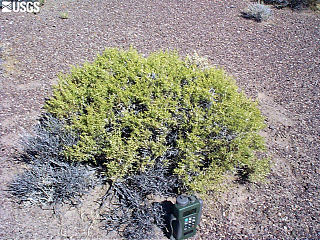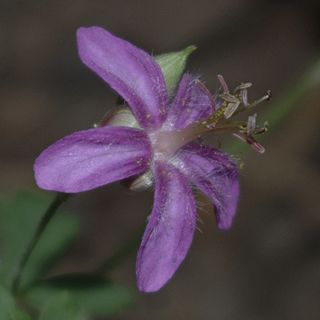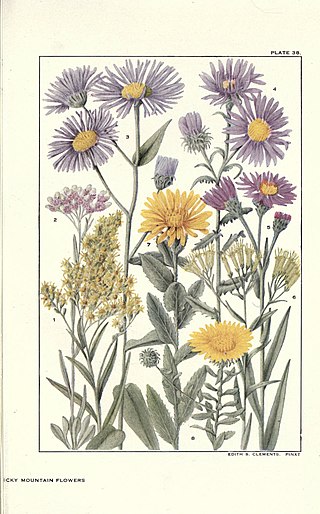
Helianthus is a genus comprising about 70 species of annual and perennial flowering plants in the daisy family Asteraceae commonly known as sunflowers. Except for three South American species, the species of Helianthus are native to North America and Central America. The best-known species is the common sunflower. This and other species, notably Jerusalem artichoke, are cultivated in temperate regions and some tropical regions, as food crops for humans, cattle, and poultry, and as ornamental plants. The species H. annuus typically grows during the summer and into early fall, with the peak growth season being mid-summer.

Sarcobatus is a North American genus of two species of flowering plants, formerly considered to be a single species. Common names for S. vermiculatus include greasewood, seepwood, and saltbush. Traditionally, Sarcobatus has been treated in the family Chenopodiaceae, but the APG III system of 2009 recognizes it as the sole genus in the family Sarcobataceae.

Ericameria nauseosa, commonly known as chamisa, rubber rabbitbrush, and gray rabbitbrush, is a shrub in the sunflower family (Aster) found in the arid regions of western North America.

Cirsium arizonicum, the Arizona thistle, is a North American species of thistle in the family Asteraceae, native to the southwestern United States and northwestern Mexico. It has been found in Arizona, southeastern California, New Mexico, Nevada, Colorado, Utah, Sonora, and northwestern Chihuahua.

Erigeron aphanactis is a species of flowering plant in the family Asteraceae known by the common name rayless daisy, or rayless shaggy fleabane. This wildflower is native to the western United States, primarily the Great Basin and Colorado Plateau regions.

Senecio flaccidus, formerly recorded as Senecio douglasii, member of the daisy family and genus Senecio also known as threadleaf ragwort, is a native of the southwestern Great Plains of North America.

Glossopetalon is a small genus of shrubs in the plant family Crossosomataceae. These plants are sometimes called greasebushes. They are native to Mexico and the western United States, where they can be found on dry mountain slopes.

Grayia is a genus of plants in the subfamily Chenopodioideae of the family Amaranthaceae. Common names are siltbush and hopsage. The four shrubby species occur in arid and semiarid regions of western North America:

Caltha leptosepala, the white marsh marigold, twinflowered marsh marigold, or broadleaved marsh marigold, is a North American species of flowering plant in the buttercup family. The species has regionally distinct variations.

Ceanothus pauciflorus, known by the common name Mojave ceanothus, is a species of flowering shrub in the buckthorn family, Rhamnaceae. It is native to the Southwestern United States and Mexico, where it grows primarily in shrubland communities at moderate to high elevations. It is characterized by oppositely arranged leaves, corky stipules and white flowers. It was formerly known as Ceanothus greggii.

Dieteria canescens is an annual plant or short lived perennial plant in the family Asteraceae, known by the common names hoary tansyaster and hoary-aster.

Geranium caespitosum, the purple cluster geranium or pineywoods geranium, is a perennial herb native to the western United States and northern Mexico. Its US distribution includes Arizona, Colorado, Nevada, New Mexico, Texas, Utah, and Wyoming.

Atriplex gardneri is a species of flowering plant in the amaranth family known by the common name Gardner's saltbush. It is native to western North America from British Columbia to Saskatchewan in Canada south to Nevada and New Mexico in the United States. The specific epithet of the species, gardneri, is misnamed after its first collector, Alexander Gordon. The naturalist Alfred Moquin-Tandon was under the impression that Gordon's last name was Gardner.

Holodiscus dumosus is a species of flowering plant in the rose family, with the common names mountain spray, rock-spiraea, bush oceanspray, and glandular oceanspray.

Cirsium eatonii, commonly known as Eaton's thistle or mountaintop thistle, is a North American species of flowering plants in the family Asteraceae.

Astragalus amphioxys, common name crescent milkvetch, is a plant found in the American southwest, including the whole of Utah, the southeast part of Nevada, the north part of Arizona, the western part of Colorado, the northwestern part of New Mexico, and one county in Texas. It was first described by Asa Gray in 1878.

Greasewood is a common name shared by several plants:

Dieteria bigelovii, also known as Bigelow's tansyaster or sticky aster, is a North American species of plants in the family Asteraceae.
Hymenopappus flavescens, the collegeflower, is a North American species of flowering plant in the daisy family.
Ira Waddell Clokey (1878-1950) was an American mining engineer and botanist active in the western United States. He first studied at the University of Illinois, then moved to Harvard University, graduating with a Bachelor of Science in mining engineering in 1903. From 1904 to 1915, Clokey worked as a mining engineer in Mexico. In his spare time he collected plant specimens for his personal herbarium, which, however, was almost completely destroyed during a fire in 1912. In 1921, Clokey completed a Master of Science in plant pathology from Iowa State University.




















